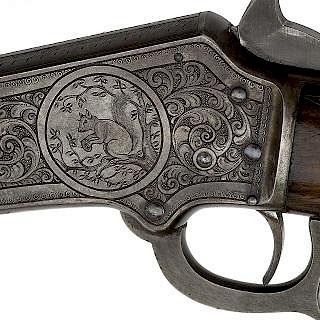Engraved Powder Horn of Josiah Morss, Dated 1760
About Seller
6270 Este Ave.
Cincinnati , OH 45232
United States
With offices in Cincinnati, Cleveland and Denver, Cowan’s holds over 40 auctions each year, with annual sales exceeding $16M. We reach buyers around the globe, and take pride in our reputation for integrity, customer service and great results. A full-service house, Cowan’s Auctions specializes in Am...Read more
Two ways to bid:
- Leave a max absentee bid and the platform will bid on your behalf up to your maximum bid during the live auction.
- Bid live during the auction and your bids will be submitted real-time to the auctioneer.
Bid Increments
| Price | Bid Increment |
|---|---|
| $0 | $25 |
| $500 | $50 |
| $1,000 | $100 |
| $2,000 | $250 |
| $5,000 | $500 |
| $10,000 | $1,000 |
| $20,000 | $2,500 |
| $50,000 | $5,000 |
| $100,000 | $10,000 |
About Auction
Oct 22, 2014 - Oct 23, 2014
Cowan's Auctions dawnie@cowans.com
- Lot Description
Engraved Powder Horn of Josiah Morss, Dated 1760
17.25" overall length. Horn is inscribed Josiah Morss Horn Ensgn of Capt Holms Company in the Year 1760M July the 29 1760. Immediately above this are the stenciled initials ES and Montreail [sic] 1760. Immediately below the main verse is Fort Stanwix in block letters and C Ray in script letters and crudely dated 1846 followed by what appears to read Ann Dam. Near the throat of the horn in block letters is the name (of a subsequent owner?) Wm C Ray. Underneath this in crudely rendered letters Livonia Livington, NY. (Livonia is in Livingston County, New York)
In a separate pane on the horn is the script Made at Lake Ontario. Ensign Josiah Morss of Canterbury, M His Horn. In another separate pane of the horn near the throat in block letters reads Josiah Morss.
Etched on the horn is a mythical human figure with wings, three trees with four soldiers rendered in marching position, crouching shooting position, standing shooting position and prone shooting position. In a separate pane are two fish and pathway with a fisherman followed by two marching soldiers and trees and a crude structure. Undulating lines, cross hatching and other geometric forms are carved throughout the horn.
Black inked notations on top and bottom edges of horn AE 9 8843 and MG 1014. Engrailed edges on top and bottom of the main body of the horn. Throat of horn has two raised carved engrailed rings.
Buttplug is carved with the date 1846 and had carved flourished initials IS and a T all of which are partially obfuscated by a small old fragment of leather secured by three nails.
This historic horn is thought to have belonged to Josiah Morss (spelled as such) who is listed as Ensign (the junior commissioned rank) in Lieutenant Colonel and Captain Israel Putnam (of later Revolutionary War fame) 2nd Company of Colonel Eleazor Fitch's 4th Connecticut Regiment during the 1760 muster (see Rolls of Connecticut Men in the French and Indian War 1755-1762. Connecticut Historical Society, Hartford, 1905, p.215). Five thousand Connecticut provincials were raised by order of the General Assembly in March 1760 to aid Crown forces during the upcoming campaign season. The roster shows that the 2nd Company was mustered in during mid-March and discharged on November 22, 1760. Putnam's Company was unusually large and experienced by the standard of the day, numbering 4 officers including Ensign Morss, 6 sergeants and five corporals, with 69 privates "who had served in some previous campaign" and "15 new privates."
During the decisive 1759 campaign the 4th Connecticut Regiment had "played an instrumental role in the capture of Fort Ticonderoga." For the 1760 campaign the provincials were mobilized primarily to garrison the chain of forts guarding the northern New York frontier thereby securing the lines of communication. This essential work was carried out while an exposed British Army under Brigadier General James Murray fought desperately to retain control of Quebec City which had been captured the previous September. Despite losing nearly a thousand regulars challenging a determined French attack during the see-saw battle of St. Foy, Murray managed to retire behind the walls of Quebec. Thanks to superior artillery, the depleted Redcoats were able to hold until the ice on the St. Lawrence melted making way for the Royal Navy to arrive triumphant on May 15, 1760. Later in September, General Sir Jeffery Amherst deftly negotiated the final terms of surrender and the long marginalized provinces of New France passed to the realm of the ascendant British Crown effectively ending the Seven Years' War on the North American continent. Parenthetically, we found the son, Josiah Morss Jr., serving in the New Hampshire militia during the Revolutionary War.Excellent.Condition
- Shipping Info
-
SHIPPING. At the request of the buyer, Cowan's will authorize the shipment of purchased items. Shipments usually occur within two weeks after payment has been received. Shipment is generally made via UPS Ground service. Unless buyer gives special instructions, the shipping method shall be at the sole discretion of Cowan's Auctions, Inc.. Cowan's is in no way responsible for the acts or omissions of independent handlers, packers or shippers of purchased items or for any loss, damage or delay from the packing or shipping of any property.
-
- Buyer's Premium



 EUR
EUR CAD
CAD AUD
AUD GBP
GBP MXN
MXN HKD
HKD CNY
CNY MYR
MYR SEK
SEK SGD
SGD CHF
CHF THB
THB








